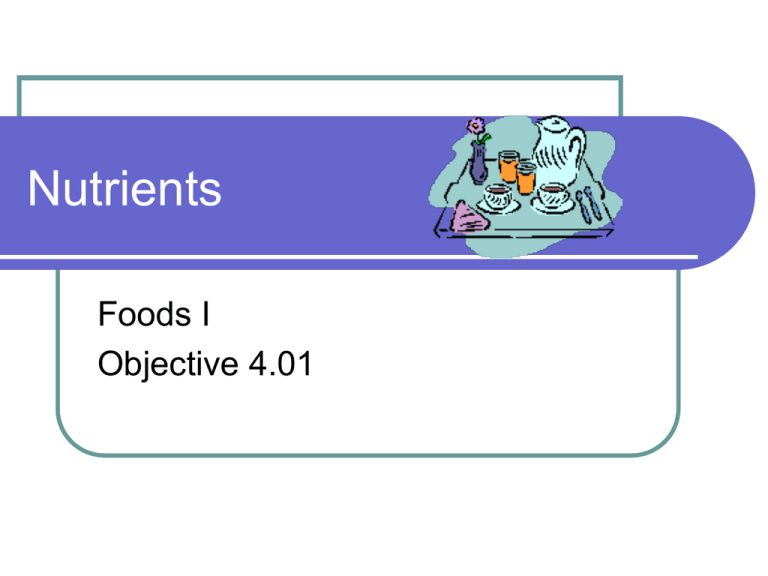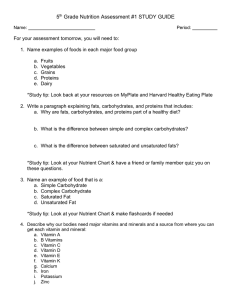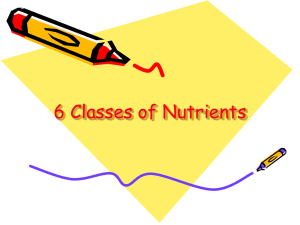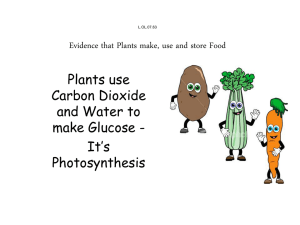4.01 Nutrients
advertisement

Nutrients Foods I Objective 4.01 Nutrients What is a nutrient? A chemical substance in food that helps maintain the body. Supply energy for the body Build cells and tissues Regulate bodily processes Breathing Nutrients Does any one nutrient supply all the body’s needs? Need over 50 nutrients for good health 6 groups of nutrients Can Fanny Play Violin Much Worse? Carbohydrates Fats Proteins Vitamins Minerals Water FYI!! Remember… Carbs = 4 cal per gram Proteins = 4 cal per gram Fats = 9 cal per gram Carbohydrates Body’s chief source of energy Known as starches and sugars Found mainly in plant sources Ex: Fruits, veggies, and grains Classified into 2 groups Simple and complex carbohydrates Complex Carbohydrates 2 types of complex carbs Starches Dietary fiber Found in dry beans, potatoes, corn, rice, pasta, and bread Piece of Orange Find fibers Complex Carbohydrates: Dietary Fiber What is fiber? Insoluble—fiber that will not dissolve in water Absorbs water like a sponge and helps move food though the large intestines Promotes regular bowel movements and prevents constipation Soluble—fiber that will dissolve in water Increases the thickness of the stomach contents Reduce blood cholesterol level Complex Carbohydrates: How much fiber is needed? American Dietetic Association recommends 20-35 grams a day How much is that? Make sure you drink enough water? Why? To avoid digestive upset Dietary Fiber Simple Carbohydrates Refined sugars Sugar extracted from plants and used as sweeteners Sucrose—table sugar (made from sugar cane, sugar beets, corn syrup, honey, maple syrup, etc) Candy Simple Carbohydrates Natural sugars in foods Fructose—fruits Maltose—grain products Lactose—dairy products Triglycerides/ Fat Also known as fats Greasy substances that will not dissolve in water Ex: butter, margarine, oils, creams, salad dressings Triglycerides/Fats Visible fats—fats that are easy to see Visible Fat Invisible fats—fats you cannot see because that are a part of the chemical make up Invisible Fat The white portions around and through meats are fats. Egg yolks, nuts, whole milk Triglycerides/Fats Why are fats needed? Functions include… Helping body absorb vitamins A, D, E, and K Reserve supply of energy Protects heart and vital organs and protects bones from injury Insulation for warmth Car crash Have you ever seen a cold polar bear? Crisco and gloves Component of cell membranes Help feel fuller after a meal Triglycerides/Fats Fatty acids Chemical structure that makes up fat Saturated fats Holds all the hydrogen it possibly can in the fatty acid Butter Raises bad cholesterol levels Triglycerides/ Fats Unsaturated fat Missing hydrogen from its fatty acid structure Monounsaturated Corn oil Missing one hydrogen Polyunsaturated Missing many hydrogen May help lower cholesterol levels if used instead of saturated. Triglycerides/ Fats Hydrogenation Taking a liquid oil into a solid Turns an unsaturated fat into a saturated fat Remember, plants don’t naturally have saturated fats! Crisco and margarine Hydrogenation forms…Trans Fats Function like saturated fats in the body Increase bad cholesterol and lowers good. Fast food, baked goods Triglycerides/Fats Omega-3 fatty acid Healthy fat Must be obtained through foods Lower risk of heart disease Found in fish oils from fish such as salmon, sardines, trout, herring Found in plant sources such as walnuts and flax seed Triglycerides/ Fats Cholesterol Fat-like substance present in all body cells Needed for many essential body processes Digesting fat Making Vitamin D Making hormones Too much Linked to heart disease Triglycerides/ Fat Cholesterol HDL All foods from animal sources contain cholesterol Plant sources don’t contain cholesterol “Good cholesterol”—H stands for healthy or happy! Picks up excess cholesterol and returns it to the liver for excretion LDL “Bad cholesterol” Takes cholesterol from the liver to where it is needed in the body Too much builds up on artery walls Cause heart disease, stroke, heart attack, etc. Proteins What are proteins? A chain of amino acids--the building blocks of protein 22 amino acids have been identified Proteins Complete and Incomplete Complete—foods from animal sources Piece of Ham Incomplete—foods from plant sources lacking at least one essential amino acid Complete Wheat Cracker With PB becomes complete Incomplete Proteins Protein is needed for… Growth and maintenance Continuous supply of proteins to grow and repair worn-out and damaged parts Growth chart Enzymes Chemical reactions Hormones Regulate conditions in the body Thyroid—regulate metabolism Insulin—maintain the level of glucose Proteins Antibodies Proteins that fight invaders Ex: Flu Fluid balance Cells life depends on fluid Too much—rupture Too little—stops activity Proteins Excess—Too much Can be harmful Broken down and stored as fat Extra work for the body to break proteins down Deficiency—Too little Kwashiorkor Discolored skin, body sores, a bulging abdomen, and listlessness (lack of energy) Found mainly in 3rd world countries Lose weight Don’t grow properly Die of starvation FYI!! Remember… Carbs = 4 cal per gram Proteins = 4 cal per gram Fats = 9 cal per gram Vitamins Needed for body to function, but only in small amounts 2 types fat and water soluble Fat soluble are A,D,E, and K All Dogs Eat Kittens Water soluble are Vitamin B group, Folate, and Vit. C Water Soluble Dissolve in water and pass easily into the bloodstream during digestion Why do you need to replace these everyday? Americans have very healthy toilets! Includes Vitamin C, Vitamin B group, and Folic Acid Vitamin C Helps maintain healthy capillaries, bones, skin, and teeth Helps heal wounds and resist infections Deficiencies Scurvy--history Poor appetite Weakness Bruising Soreness in joints Vitamin B1--Thiamin Helps turn carbs into energy Needed for muscle coordination and a healthy nervous system Deficiencies Beriberi--history Irritability Nausea Apathy Insult someone absence of interest or concern to emotional, social, or physical life Loss of appetite Vitamin B9 Folic Acid Functions: Prevents birth defects that damage the brain and spinal cord Build red blood cells Form genetic material (DNA) Helps the body use proteins Protect against heart disease Deficiencies Anemia Alters red blood cells to they carry less oxygen Feeling tired and weak Develop diarrhea and lose weight Fat Soluble Vitamins absorbed and transported by fat Include A, D, E, and K All Dogs Eat Kittens Vitamin A Promote good vision and help maintain tissues and skin Have you ever seen a rabbit wearing glasses? Why not? Because they eat so many carrots rich in Vitamin A. Supports reproduction and growth Deficiencies Rough, scaly skin Infections of the respiratory tract Night blindness A condition making it difficult or impossible to see in relatively low light Walk inside after being outside Dark movie theater Vitamin D Maintains levels of calcium and phosphorus in the blood Found in sunlight and fortified milk Excess Nausea, vomiting, and hardening of soft body tissues Deficiencies Osteomalacia Aka Rickets--history Weak and deformed legs Vitamin E Antioxidant Protects cells from damage Not useful in body lotions, soap, etc. Like putting Tylenol on your head in the hopes of getting rid of a headache. Reduce the risk of heart disease and some cancers Deficiency—rare due to so many sources Vitamin K Helps blood clot so that wounds stop bleeding—history “Klotting” Band-aid Assists proteins with bone health Deficiencies--rare Minerals Make up 4-5% of your body weight Vital to good health Functions Make substances that your body needs Teams with vitamins in chemical reactions Become part of your body structure Teeth and bones Minerals Macro-minerals Major Minerals Micro-minerals Trace mineral Small amounts needed—excess can be harmful Micro Machines Commerical Macro-minerals: Calcium Helps regulate blood clotting, nerve activity, and other body processes Needed for muscle contraction (including the heart) Keep teeth and gums healthy Keeps bones strong Macro-minerals: Calcium Deficiencies Osteoporosis affects 10 million Americans Causes bones to become porous, making them weak and fragile May result in a stooped posture and bones may break easier Calcium Curves Macro-minerals: Magnesium Functions Helps build bones and proteins Helps nerves and muscles work normally Contributes to proper heart functions Deficiencies are not common Found in… Bran cereals, soy milk, and yogurt Macro-minerals: Potassium Functions Helps maintain a steady heartbeat Helps with muscle and nerve action Deficiencies Muscle cramps Usually rare Macro-minerals: Sodium Functions Helps with muscle and nerve action and regulate blood pressure Regulate cell fluids Deficiencies Loss of calcium Increase the risk of kidney stones Excess Hypertension High blood pressure Lead to cardiovascular disease and strokes Macro-minerals: Phosphorus Functions Works with calcium to build strong bones and teeth Helps release energy from carbs, fats, and proteins Helps build body cells and tissues Deficiencies Unknown Micro-minerals: Iron Iron = Fe Females need more iron Functions Making hemoglobin The substance in red blood cells that carries oxygen to all body cells Deficiencies Pica Unusual appetite for ice, clay, or other nonfood items Iron-deficiency anemia Tired, weak, short of breath, pale Cold Women are more prone due to having a period Remember… Raisins are wrinkled and need to be ironed. Micro-minerals: Iodine Functions Stored in thyroid gland Produces substances needed for growth and development Deficiencies Goiter Mental retardation Water Makes up 55-75% of a mature body Main component of all body fluids Blood, saliva, digestive juices, urine 3 rule 3 minutes without air 3 days without water 3 weeks without food Ocean of Fear Water Functions Chemical reactions Helping break food down into nutrients Transportation of nutrients Cushioning and moisturizing Cushions joints, tissues, and organs Keeps eyes, mouth, and nose moist Water Waste removal Temp regulation Sweating to keep body from overheating Breathing Adds moisture to air for lungs Removal of water from lungs Overall well being Water How much is needed daily? 8-8oz cups or 64 oz total Other foods meet water requirements 37% of water intake comes from food Sodas, coffee, and/or caffeinated drinks can deplete your system of water Deficiencies (Dehydration) Thirst Dryness of mouth Weakness Dark colored urine Flushed skin Fever Death Ocean of Fear 1 Ocean of Fear 2 Ocean of Fear 3








